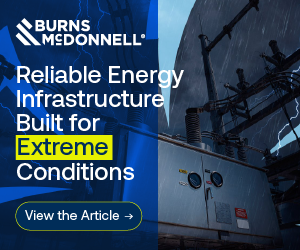What to Keep in Mind
Joaquin Ramirez is the Founder of Technosylva.
The escalating wildfire risk has created an energetic and collaborative approach from electric utilities and state regulators. The question has shifted from whether or not these lower frequency, high-consequence events are a concern, to how stakeholders can move beyond simply reacting to wildfires and proactively mitigating this ever-present danger.

Utility executives and regulators are working decisively toward implementing demonstrable measures that prevent ignitions and minimize community and landscape impacts. These are the right actions not only for the safety and economy of every community, but also to maintain the viability of critical electric utility operations in the face of outages and issues with credit ratings and insurability.
These are critical decisions and actions facing smart and responsible leaders who usually have great experience with policy, operations, and risk management, but not necessarily extensive experience with wildfire. So, what are the key things utility executives and regulators need to keep in mind as they chart the forward path?
Three Wildfire Considerations
First, wildfire behavior and its related risks are inherently dynamic, not static. The confluence of weather patterns, fuel conditions, and the very landscape itself are in constant flux. What might be a low-risk day can transform in a matter of hours with a shift in wind or a drop in humidity.
This has profound implications for both operational decisions and medium-term mitigation strategies. Public Safety Power Shutoffs (PSPS) and Enhanced Power Line Safety Settings (EPSS), intended as proactive safety measures, must be agile, surgical, and responsive to these ever-changing conditions.
Similarly, vegetation management and asset hardening, while crucial long-term investments, need to be prioritized and adapted based on a continuously evolving understanding of risk across service territories. While many utilities start with a well-researched Wildfire Management Plan, these changing conditions require dynamic and continuous management, informed by investments in ongoing situational awareness.
Second, confronting wildfire means dealing with extremes, not averages. Wildfires are overwhelmingly likely to ignite and spread under conditions that reside in the far tail of the statistical distribution, often above the ninety-fifth percentile for key environmental factors.
A forty mile-per-hour wind in a historically sheltered area, coupled with critically dry fuels, can pose a far greater risk than a sixty mile-per-hour wind in a region accustomed to high winds and potentially different fuel loads or dryness conditions. Relying on generalized and expected conditions, typical weather forecasts or insufficiently accurate and granular data provides an incomplete, or worse yet, an inaccurate picture of real risk.
Decision-making frameworks must be calibrated with available specialized forecasting and consideration of these extreme scenarios, recognizing that the most devastating ignitions often occur outside the bounds of everyday experience.
Predicting these extremes is hard. Standard weather reports and Red Flag Warnings are valuable but often lack the granularity of the rare, high-impact conditions necessary for truly informed decision making. These conventional sources may not adequately capture localized microclimates, extreme wind gusts, or the precise fuel moisture content in the most vulnerable areas most relevant to utility infrastructure.
They can leave electric utilities unprepared to recognize conditions that are most likely to lead to catastrophic ignitions and rapid fire spread. AI tools that utilize both fire science and machine learning are most useful here, as the data sets for fire are smaller and much more specialized than typical large weather data or other generalized AI.
The extreme nature of wildfire risk is further underscored by recent sobering statistics. In Southern California last January, three hundred seventy-four wildfire ignitions were seen during the three days of an extreme Santa Ana event, with many others likely averted by proactive measures like PSPS.
The vast majority of these ignitions were contained at initial attack, a testament to the effectiveness of existing mitigation and response efforts by fire agencies and electric utilities.
Yet, a small fraction – less than half a percent – escalated to become the devastating wildfires that led to immense loss.
This highlights a crucial paradox: electric utilities strive to continuously reduce the chance of an event where many recent measures were already statistically effective (>99.5%). This reality necessitates adopting a highly targeted and data-informed approach, continuously identifying and mitigating the extreme conditions and locations that elevate risk from a contained incident to a catastrophe.
Third, critical decisions around wildfire and extreme weather require critical data. The complexity of fire behavior – environmental factors, ignition, weather complexity, the interaction between weather and fuels, topography – means that seemingly obscure data inputs can have meaningful impacts on the answers required for decision making.
Executives and regulators need time-specific, location-specific, high-quality and quantified answers to questions such as: “Where is a fire going? Where are we most vulnerable to an event? How bad could this event be?” All to execute decisions on safety, mitigation, line de-energization and resource placement.
To get the answers they can trust, they need to have trust that the inputs and interactions that produce those answers are well founded. For example, a mischaracterization of the height and moisture level of grass or shrubs can produce a four to ten times difference in the prediction of the size and speed of a fire. This type of high-quality data distinction drives proper assessment of real risk instead of just ignition probability, avoids unnecessary PSPS, and when absolutely necessary enables PSPS surgically by limiting the scope, scale, and duration.
Looking Ahead
Electric utilities and regulators have the power to make key operational and policy decisions and investment plans in the coming months that can greatly reduce the impact of wildfires and extreme weather. The nature of fire – dynamic, extreme, and complex – is at the heart of these decisions.
While this may seem intimidating to understand, lessons and tools from many western states are already being adopted effectively nationwide, even by smaller municipal utilities with limited resources. Developing some of these basics of wildfire understanding, our leaders are becoming better equipped to assess both risk and consequence and make the most informed determinations to protect their communities and the critical services they provide.



